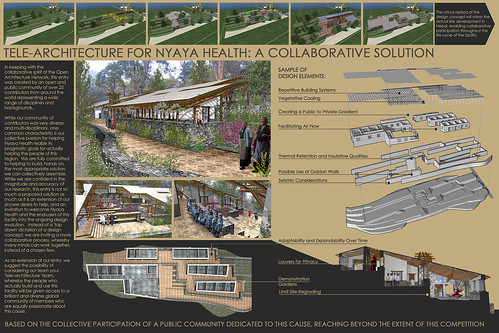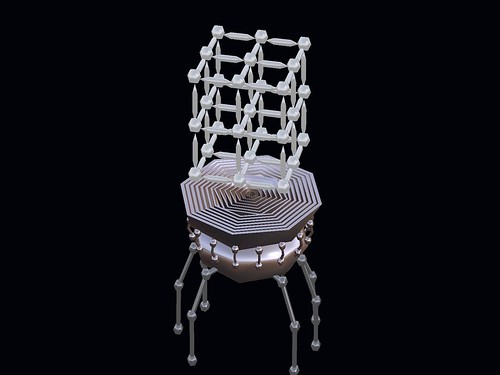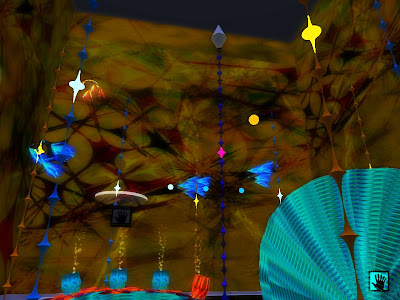Addendum: (Can you put an addendum at the beginning?)
I wrote this ahead of the announcement that Philip was being replaced as CEO of Linden Labs. Philip’s initial vision has been partially co-opted by a lack of a coherent operational and marketing strategy. Enamored with the technology and with possibilities, Rosedale has led Second Life to where it needs to be in the first phases of its evolution. However, coupling this vision (and Philip will remain as an evangelist and product developer) with a new CEO who will (hopefully) bring renewed vigor to enabling key user streams within Second Life, can finally help to lift this boat before competition and disgruntled users slip into the tides. This is a test bed for a conceptual age, but it also serves diverse communities.
A new CEO can not only clean up the operational issues, hire a CTO, but can also rally the troops around a vision that marries a deeper vision for the potential of virtual worlds and a compelling story and execution targeting stakeholders, external partners, developers, and the internal constituencies. Strategy includes not just technical excellence but in most books includes balancing internal and external needs, operational effectiveness and value propositions with cost and quality, and so on. Rosedale’s skill set is as a visionary and evangelist for where these worlds will take us.
The timing of my original post, in ignorance of Philip’s change, now feels more meaningful (to myself in any case) than my usual pointless Friday rambling.
Rewriting the World
Let’s say we’re going to rewrite the world. Visions of utopia have been kicking around since that apple, but this time we’re going to mix in a lot of tech savvy and the wacky, tripped out sensibility that only people in California can naturally muster. So we’re casting around for a model, and out in the desert find a society that gets built up and burned down every year. Burning Man.



Images: Burning Man.
So here’s the vision: use code to enable a society built on the idea of collaborative creativity. Make the tools rich and robust, even if it means there’s a learning curve to using them – we’re man after all, evolved from our tools, surely another evolution in our toolset will empower change? Improve the tools over time. Improve the setting for the shared creative output – enhance the water or sky, improve the physics, and work hard to remove the things that prevent a suspension of belief – get rid of the glitches and lags if we can, scale the thing up. And while we’re at it, let people own their creations and choose to sell them to each other if they wish.
Not such a bad vision really. A sort of free-flowing, wacked-out carnival. Just like Burning Man, maybe the people who visit this place will go back to their home towns not just sun burnt, but enlightened. Wagner Au calls it Be Bop reality and Mirrored Flourishing, but whatever…it’s the idea that if you rewrite the world with the idea of the creative carnival it’s going to have a bit of anarchy, a lot of improv, and maybe we’ll all learn something and benefit from it.
Being Digital
In 1996 Nicholas Negroponte predicted the rise of the digital:
The next decade will see cases of intellectual-property abuse and invasion of our privacy. We will experience digital vandalism, software piracy, and data thievery. Worst of all, we will witness the loss of many jobs to wholly automated systems, which will soon change the white-collar workplace to the same degree that it has already transformed the factory floor. The notion of lifetime employment at one job has already started to disappear.
The radical transformation of the nature of our job markets, as we work less with atoms and more with bits, will happen at just about the same time the 2 billion-strong labor force of India and China starts to come on-line (literally). A self-employed software designer in Peoria will be competing with his or her counterpart in Pohang. A digital typographer in Madrid will do the same with one in Madras. American companies are already outsourcing hardware development and software production to Russia and India, not to find cheap manual labor but to secure a highly skilled intellectual force seemingly prepared to work harder, faster, and in a more disciplined fashion than those in our own country.
The challenges of the digital age were tempered by Negroponte’s optimism:
Bits are not edible; in that sense they cannot stop hunger. Computers are not moral; they cannot resolve complex issues like the rights to life and to death. But being digital, nevertheless, does give much cause for optimism. Like a force of nature, the digital age cannot be denied or stopped. It has four very powerful qualities that will result in its ultimate triumph: decentralizing, globalizing, harmonizing, and empowering….
But more than anything, my optimism comes from the empowering nature of being digital. The access, the mobility, and the ability to effect change are what will make the future so different from the present. The information superhighway may be mostly hype today, but it is an understatement about tomorrow. It will exist beyond people’s wildest predictions. As children appropriate a global information resource, and as they discover that only adults need learner’s permits, we are bound to find new hope and dignity in places where very little existed before.
My optimism is not fueled by an anticipated invention or discovery. Finding a cure for cancer and AIDS, finding an acceptable way to control population, or inventing a machine that can breathe our air and drink our oceans and excrete unpolluted forms of each are dreams that may or may not come about. Being digital is different. We are not waiting on any invention. It is here. It is now. It is almost genetic in its nature, in that each generation will become more digital than the preceding one. The control bits of that digital future are more than ever before in the hands of the young. Nothing could make me happier.
Playing with Atoms
One of the brilliant insights of Philip Rosedale and Linden Lab’s development of Second Life was the atomization of content. Prims are atoms allowing users to create from the smallest unit up. The choice seems kind of obvious now, but it could have just as easily been built from the perspective of a game play system, or as a “user mod” environment.
Worlds and platforms that have followed either take Linden’s lead or are being constructed from different paradigms – over at Metaplace, it’s all about standards and the interoperability and “plug & play” that the “HTMLing” of virtual worlds would provide. Other environment are constructed from a social paradigm, emulating a Facebook for virtual worlds, or creating media/socialization platforms like Kaneva. Over at RealXtend, they’re attempting to append the atomization of content with a more robust avatar system.
In Second Life, new users become confounded because they’re expecting a social space with all the tools they’ve come to expect from mySpace and instant messaging. Or they want a game environment, with clear levels and pathways. Educators struggle to find course management systems and tools that at least look something like Blackboard or Moodle (thank goodness for Sloodle and NMC). So, maybe there’s stuff that’s familiar but then there’s a lot that’s unfamiliar as well, and the ‘rules of the game’ are held in those little atoms, and the joining of those atoms with others, and a strange cascade of content which is disguised as a building, or commerce, or buying a house. But there’s something deeper going on in those atoms, and for the users with the patience to stick around and figure it out, they start to see hints of those deeper things.
At its most pragmatic, they might stumble across the Wikitecture project and find out that a group of SL citizens have designed a health center for a village in Nepal:

And then they might dive a little deeper.
What’s Impossible
This is an avatar:

So is this:

According to Bettina’s interview with their creator, these avatars are developed with reference to astrobiology. Yoa Ogee comments that “Our avatars should enhance tolerance and should be available for everybody. I know as an alien: humans are a very cute and friendly species… sometimes they just forgot it.”
This is dance, and it crosses over from the real to the virtual:

What’s important about these things that aren’t possible is that they’re both thought streams arising from the atomization of content. In building the world from the prim up, the creative classes of Second Life are re-imagining the world and slowly making new concepts, about everything from identity to science, possible.
A Nation of Shopkeepers
But those are just tiny streams in a wider culture. And in the wider culture people shop, they fall in love, they buy, rent or build houses, dance, chat, argue, and live. They’re a Neko for a night or a furry. They create communities. They shoot at each other in the City of Lost Angels and engage in deep role playing on Sci Fi or Gorean sims.
And inevitably, they make stuff. There’s lots of stuff in SL – billions of objects. But sometimes you just can’t find the specific thing you’re looking for so you make it yourself. And then realize that there’s probably someone else out there that wants the same thing so you set up a vendor and you’re in business. And before you know it, Second Life is a living example of The Long Tail – there may be a few “top sellers” but the economy is driven by a lot of little niche transactions – objects with a few buyers, a massive micro economy, and a few aggregators like SLExchange helping to mop up all the little bits of content and make it easy for the masses to buy and consume.
I Am a Node
In this atomic universe the users are the stars, clustering together around slices of experience, riding the waves of data and shared environments, connecting and swapping content.
Map the connections. We’re probably a few dots apart. The clusters as tribes and someone’s keeping track – we’re leaving footprints in the digital sand, and we’re starting to get worried about whether we can erase our tracks if we take a wrong turn, or who’s going to own the maps in the first place, whether it’s such a hot idea that Google is managing medical records, or whether we’re happy about using Linden’s age verification service.
I wrote about tribal versus territorial morality and then ran across this quote from McLuhan:“Modern man – that’s us now — feels obligated to be punctual and conservative of time, tribal man bore the responsibility of keeping the cosmic clock supplied with energy. But electric or ecological man (man of the total field) can be expected to surpass the old tribal cosmic concern with the Africa within.”
We’re becoming electric man, and Second Life is the test drive. Recreating the universe one atom at a time, and then stepping out and finding ourselves dislocated.
Have a look at what happens when we try to port our old ideas and paradigms into the new space. Last time I checked, CSI New York was relegated to a few lonely and disheartened looking sims.

In the meantime, content creators within Second Life are finding their businesses at risk as the latest rash of copybots devours skins, prims and entire avatars.
The Grid is electric, the Grid is digital, and as Negroponte pointed out 12 years ago, content theft, piracy and plagiarism just become way too easy. But coupled with the dangers to content expression and ownership are the opportunities. As he pointed out:
The crisp line between love and duty will blur by virtue of a common denominator–being digital. The Sunday painter is a symbol of a new era of opportunity and respect for creative avocations–lifelong making, doing, and expressing. When retired people take up watercolors today, it is like a return to childhood, with very different rewards from those of the intervening years. Tomorrow, people of all ages will find a more harmonious continuum in their lives, because, increasingly, the tools to work with and the toys to play with will be the same. There will be a more common palette for love and duty, for self-expression and group work.
Computer hackers young and old are an excellent example. Their programs are like surrealist paintings, which have both aesthetic qualities and technical excellence. Their work is discussed both in terms of style and content, meaning and performance. The behavior of their computer programs has a new kind of aesthetic. These hackers are the forerunners of the new e-xpressionists.
This doesn’t condone acts of theft. Theft is still theft. But there’s a fine line between flexibility, hacking, and theft. In a community whose very purpose is self expression and collaboration, the object economy was always an add-on to an atom-based universe. Maybe a deeper palette, as Negroponte suggests, is needed, something like what’s expressed in the Creative Commons which “provides free tools that let authors, scientists, artists, and educators easily mark their creative work with the freedoms they want it to carry. You can use CC to change your copyright terms from “All Rights Reserved” to “Some Rights Reserved.”"
Append it with ‘number of use’ rights, include the ability to allow a specific number of transfers or copies instead of just blanket use, and maybe you’d start to see a deeper IP environment.
The Conceptual Age
I was called an augmentationist, looking for the killer app of Second Life. It’s strange because I don’t feel like one. But maybe I’ve been misinterpreted because I talk about the real so much, and talk about how the real and the virtual co-mingle.
But I talk about these things because virtual worlds, and Second Life in particular (for now), with its atom-based platform, give the first deep glimpse into the meaning of being digital, into the emergence of McLuhan’s electric man.
For business, it extends Web 2.0 and The Long Tail into a space where the line between producer and consumer blurs to the point of being indistinguishable. Even the most talented content creators in SL are finding that it’s not enough to sell objects, they’re tasked with creating environments, experiences, and with attaching community, social and brand values to otherwise copiable, digital artefacts (although I’m not arguing that objects should be easily copiable, but I am arguing that that these higher levels of creativity are what are required to truly thrive). Businesses can’t just open a store, spritz in some buy-inducing smells and music, and watch product fly off the shelf. This is a new economy in which even the smallest niche has value, and in which those small niches vastly out number the larger ones, which are vastly out numbered again by the gift economy.
For individuals who live and play in virtual worlds, there are new lessons about how the digital world starts to shift social norms from territorial morality (what’s mine is mine, and the protection of my ‘property’ is sacrosanct) to a tribal one (our shared good, including the shared protection of our collaborative creation, is sacrosanct). Whether a good thing or bad, virtual worlds clearly show a shift towards establishing tribal connections and maintaining social norms, whether its on Facebook or Caledon.
These aren’t just IP issues. Or code issues. These are the early indicators of an emerging cultural, economic and conceptual shift, one that’s already washed over the Web, but whose full significance is being played out in virtual worlds, walled gardens whose walls are starting to crack. But the collapse of these walls doesn’t mean that I believe the significance is in letting the real IN, the significance for me is in letting the virtual OUT.
Back to Paradise
Brad Warner wrote in Hardcore Zen:
The world is better than paradise, better than any utopia you can imagine. I say that in the face of war and starvation and suicide bombings and Orange Terror Alerts. The world is better than Utopia because – and follow this point carefully – you can never live in Utopia…Maybe you can go to a paradisiacal island, far away from your boss and your bills and anything else you want, but pretty soon you’ll be complaining that you’ve got sand up your ass, or the snack machine ate your dollar, or hermit crabs stole your thongs.
You can’t live in paradise – but you are living right here. Make this your paradise or make it your hell. The choice is entirely yours.
There’s no ideal society out in the desert at Burning Man. Sure, some people come back enlightened, but some also come back with sun stroke or needing a month of sleep to recover from the drugs. But as he points out:
You’re alive when you’re sitting in your bedroom cleaning wax out of your ears. You’re alive when you’re at the supermarket wondering whether to go for the Hostess HoHos or the Little Debbies. You’re alive right now. Just be what you are, where you are. That’s the most magical thing there is. The life you’re living right now has joys even God could never know.
This journey into virtual worlds, the rabbit hole, the strange loop, the magic circle – call it what you will, it’s damn strange in here. It’s a universe being built up atom by atom, sim by sim, house by house and even the thousands of hairs on your head were carefully constructed.
Philip Linden told Wagner Au that he harbors fantasies of immortality through the code. He imagined a day, I suppose, when we can swim not just through landscapes of malls and beach houses and ethereal sculptures and all the stuff that isn’t possible in real life, but instead swim through an aggregation of information and ideas, concept maps built from prims appended to and sharpened by those who follow, mirror worlds and augmented ones, and the footsteps left behind make us immortal – electric man, awakening the Africa within.
Maybe so. Maybe this reconstruction of the world is also the reconstruction of our very mortality. Time will tell.


Past Atoms
For now, the question is what happens when we extend this universe of atoms up the chain. Our new user danced a little. Bought a slice of land and went shopping. Visited an art installation or two. Talked to people. And started to FEEL things – love, sure, but also other things, strange dislocations. Started digging into those atoms a bit more and realized that some of them were being assembled to make virtual cars and clothes, but some of them were being assembled as tools for collaboration. Some of them were challenging our beliefs about identity. Some of them were even being turned into intelligent life forms.
We’ve heard a lot about education and business collaboration in Second Life – the next “wave” according to Rosedale (who has been famous for his inability to predict what would happen every time he introduced a change to SL). In the meantime, there’s people who don’t care about virtual classrooms, but are looking to create objects with embedded learning algorithms (sort of extended versions of the SL Browser that capture more than just tags), or to extend the Wikitecture into conceptual development rather than just physical, or who are embedding SL environments with RL data streams like IBMs Virtual Networks Operation Center.
In creating the world from the atom up, Rosedale thought he’d end up with Burning Man, and although the carnival is always on, there are other streams that have been unleashed as well, rivers of thought that leave behind our attachments to the concepts of property and purchase that continue to explore how powerful this idea really is – how far we can push the prims, and how many sacrosanct beliefs we can overturn on the journey.



[...] prior to Philip stepping down (or is it up?) from his role as CEO I wrote: “So here’s the vision: use code to enable a society built on the idea of collaborative [...]